Boggo Road Ecosciences Precinct; high tech laboratory on an old gaol site
Bill Dennison ·A new scientific facility in Brisbane is the Ecosciences Precinct on the site of the old gaol (jail) which was known as Boggo Road. The facility is just across the Brisbane River from the University of Queensland, connected by the new Eleanor Schonell pedestrian, bicycle and bus bridge. The Ecosciences Precinct is a partnership between Queensland government and the federal government, with the respective scientific organizations from state and federal government co-locating and sharing facilities. The major organizations are Queensland Department of Environment and Resource Management (DERM), Queensland Department of Employment, Economic Development and Innovation (DEEDI) and Commonwealth Scientific & Industrial Research Organisation (CSIRO).
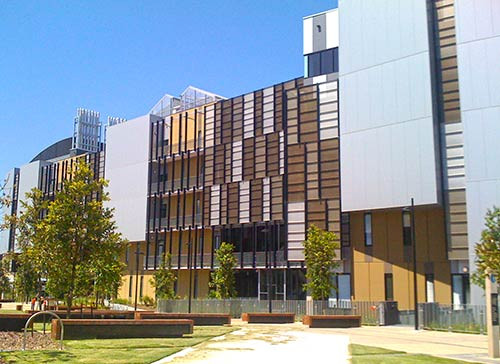
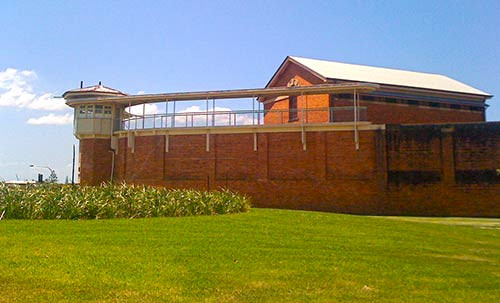
The first thing you notice approaching the building is the lack of automobile parking. The site is adjacent to a train station and a busway, and various bikeways also connect the facility to public transportation. There is parking underneath for official cars and visitors as well as parking for a fleet of small boats, but regular employees are expected to use public transportation.
A portion of the old gaol is still standing and is being renovated for historical tours in the future. The Ecosciences Precinct building (actually three interconnected buildings) actually has a few gaol-like features. 1) There is a security system with guards at the front desk and visitors are required to sign in (but no body searches). 2) The windows have cross bars which look like gaol bars. 3) The swipe cards have time limits so some people have only 9 am - 5 pm access, some have 5 am - 9 pm access and others have 24 hour access (e.g., trustees). 4) The three buildings are called A, B and C, like Cell Block names. 5) Some of the meeting rooms have heavy, electronic sliding doors.
There are several interesting features to the layout of the Ecosciences Precinct. One strategic decision was to have scientists from the different organizations interspersed throughout the building, rather than a DERM building, DEEDI building and CSIRO building. Another decision was to have an open plan for offices, with a 90:10 ratio of cubicles to offices in the state facilities and a 70:30 ratio for CSIRO facilities. The partitions are rather low in most areas, contributing to the open look. In addition to the open plan layout, there are glass floor to ceiling walls in most laboratories, offices and meeting rooms. There are large common areas on each floor for food preparation and eating. The cafe in the lobby is very nice and the light and airy hallways are pleasant.
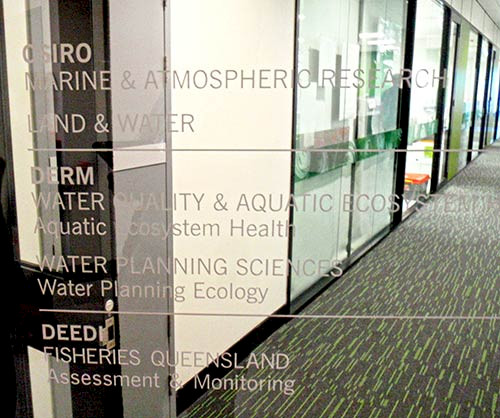
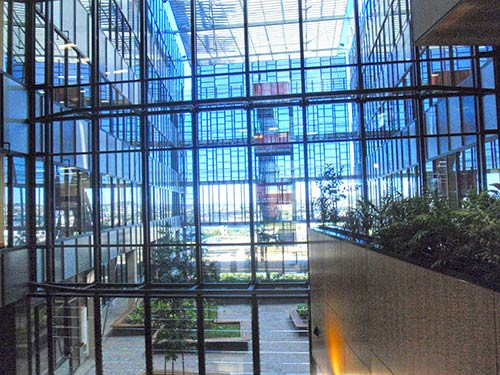
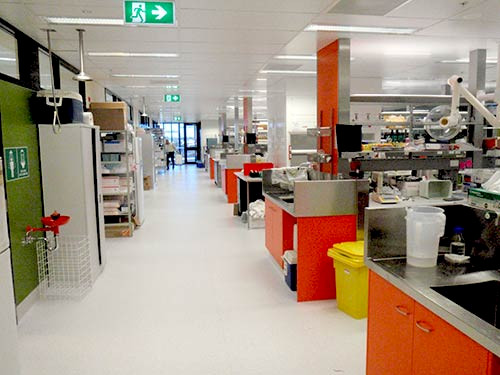
The boat shed area in the lower level was quite spacious and the wet labs and walk in freezers were also expansive. The boats would need to be trailed to the various waterways, but Boggo Road is a relatively central location. We saw the Integrated Marine Observing System (IMOS) laboratory where the technicians were breaking down the sensors that had just been swapped out from the 62 meter deep station just offshore of South Passage separating Moreton and North Stradbroke Islands.
While the Ecosciences Precinct is a modern facility with many nice features, I wonder at the wisdom of so much open space when scientists often need quiet space to work. The lack of a large seminar room or theater also seems to be an oversight. There is no flowing seawater system, like the CSIRO facility in Cleveland had, so scientists reliant on flowing seawater use the facility on Bribie Island, just to the north of Moreton Bay.
Dr. Peter Rothlisberg provided a tour of the facilities and I ran into several previous colleagues and former students. There is a huge advantage of having so many scientists in one place, instead of scattered in small pockets throughout the city. Peter and I talked about the evolution of marine science and we have both spent the majority of our careers at marine laboratories in relatively remote locations, in contrast to the large urban Ecosciences Precinct. One of the important features of the small marine labs is the sense of community that develops in that setting, and we are curious as to the esprit de corps that develops from the Ecosciences Precinct.
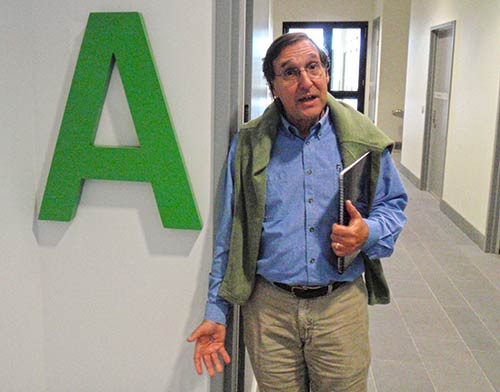
One of the constants in science is change. The tools and techniques change rapidly and our sensor technologies are exploding in versatility and in data gathering capacity. The amount of time scientists spend in the field and in laboratories has diminished and computers are the major tool used by scientists. Science has become more collaborative than before as well. The design of scientific facilities needs to reflect these changes and also be adaptable to the new changes that are sure to come along. The Ecosciences Precinct will be an interesting experiment in accommodating these changes and it will be interesting to check back in a few years to see how this experiment is working out.
About the author
Bill Dennison

Dr. Bill Dennison is a Professor of Marine Science and Interim President at the University of Maryland Center for Environmental Science (UMCES).
Next Post > Queenscliff, Bellarine peninsula and Victoria embayments
Comments
-
Atika 5 months ago
Thank you for sharing this great information with us, i really appreciate your post!